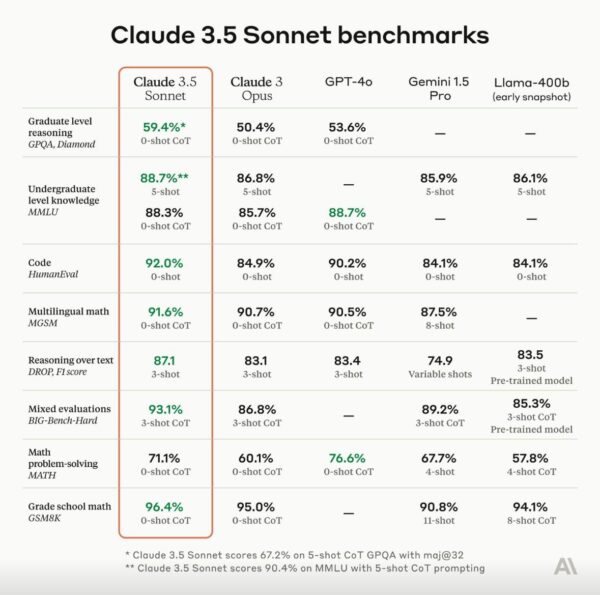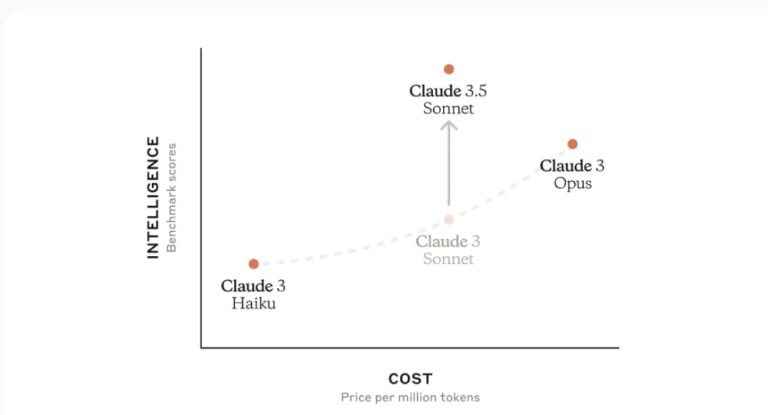Anthropic has introduced Claude 3.5 Sonnet, the latest addition to its Claude 3.5 model family, setting a new benchmark in artificial intelligence capabilities. Launched today, Claude 3.5 Sonnet is designed to surpass its predecessors and competitors, offering superior performance in various evaluations while maintaining the speed and cost-efficiency of the mid-tier Claude 3 Sonnet model.
Claude 3.5 Sonnet establishes new industry standards in several key areas. The model excels in graduate-level reasoning (GPQA), undergraduate-level knowledge (MMLU), and coding proficiency (HumanEval). It demonstrates significant improvements in understanding nuances, humor, and complex instructions, making it particularly adept at producing high-quality content. Also, one of the standout features of Claude 3.5 Sonnet is its operational speed, which is twice that of its predecessor, Claude 3 Opus. This enhanced performance, coupled with its cost-effective pricing, positions Claude 3.5 Sonnet as an ideal solution for complex tasks, including context-sensitive customer support and the orchestration of multi-step workflows. The speed and efficiency of this model are expected to significantly benefit businesses by reducing response times and improving the overall user experience.
Advanced and specific Skills
Claude 3.5 Sonnet also brings robust coding capabilities to the table. When provided with appropriate instructions and tools, the model can independently write, edit, and execute code. Its sophisticated reasoning and troubleshooting abilities enable it to handle code translations effortlessly, making it particularly effective for updating legacy applications and migrating codebases. These capabilities are expected to be a game-changer for developers, allowing them to streamline their coding processes and improve the quality of their software.
But the visual processing development is not far behind. That new model represents Anthropic's most advanced vision model to date. It outperforms Claude 3 Opus on standard vision benchmarks, showing notable improvements in tasks that require visual reasoning, such as interpreting charts and graphs. The model can accurately transcribe text from imperfect images, a vital capability for industries like retail, logistics, and financial services. This ability to glean insights from images, graphics, and illustrations enhances its utility in environments where visual data is as critical as text-based information.

Implications and Future Prospects
The launch of Claude 3.5 Sonnet marks a significant milestone in the AI industry. By combining advanced intelligence with speed and cost-efficiency, Anthropic aims to broaden the scope of AI applications across various sectors. The model's capabilities in natural language processing, coding, and visual reasoning make it a versatile tool for businesses looking to leverage AI for complex, context-sensitive tasks.
As AI continues to evolve, the introduction of models like Claude 3.5 Sonnet highlights the ongoing advancements in the field. Anthropic's commitment to pushing the boundaries of AI technology ensures that businesses and developers will have access to cutting-edge tools that can drive innovation and efficiency across multiple domains. Claude.ai also includes Artifacts, a new feature that expands how users can interact with Claude. When a user generates content like code snippets, text documents, or website designs, these Artifacts now appear in a dedicated window alongside their conversation.
For now, Claude 3.5 Sonnet is accessible via the Anthropic API, Amazon Bedrock, and Google Cloud's Vertex AI. The model has a price of $3 per million input tokens and $15 per million output tokens, featuring a 200,000 token context window.





